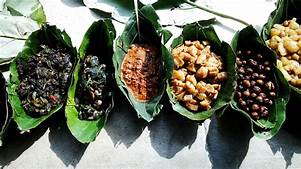On the off chance that you’ve at any point culled a blackberry off a shrub or singed up a fish you trapped in a lake, you’ve plunged a toe into the universe of wild food. Despite the fact that the food framework in the main world spotlights on filling our plates by means of tamed sources, there’s in reality a great deal to be said for sourcing and devouring food sources found in the wild. Truth be told, some wild food varieties accompany some astounding medical advantages! (What’s more, you don’t need to be an agrarian to encounter them.)
Notwithstanding, there are likewise some significant worries about the security of eating non-trained natural products, veggies, and meats. Here’s a gander at whether it’s a smart thought to go wild with your food, and how to do it securely.
Wild versus Cultivated Food
Wild food has no official definition, and there’s surely a range of what “matters” in this classification. By and large, however, wild food can be any palatable plant that develops without development by people, or any creature taken from its regular territory for human utilization. This, obviously, varies from the cultivated harvests and trained creatures that make up by far most of the standard Western eating routine.
Instances of Wild Foods
At the point when you look carefully, it’s not difficult to see that the Earth is abounding with wild food varieties. Wild game in the U.S. incorporates creatures like deer, elk, goose, turkey, and some more. Also, a variety of leafy foods develop untended in numerous spots around the country. Various assortments of berry hedges produce consumable organic products, while mushrooms line timberland floors. Specialists gauge that there are more than 2,000 palatable and restorative mushroom assortments across the globe.
Indeed, even a portion of the weeds that fill in your yard may really be wild greens you could add to a serving of mixed greens, like dandelion or roan.
Nuts, spices, tree organic products, and cactus cushions (likewise called nopales) are extra instances of food varieties that develop all alone, even in metropolitan regions.
Healthful Differences of Wild versus Cultivated Foods
There are various occasions where wild food sources are in reality more nutritious than their cultivated partners. This probably has to do with their inborn guard methodologies.
“Living in the wild is hazardous and unpleasant for all animals, including plants. The pressure that wild plants go through makes them create defensive systems to help them endure.” – Kitty Broihier, MS, RD, LDN, of the Wild Blueberry Association of North America
Phytochemicals
A few plants do this by growing thistles or transmitting a disagreeable smell, while others make severe tasting substance mixtures to deflect hunters. “These mixtures are called phytochemicals, and examination proposes that in bunches of cases, those equivalent harsh synthetic substances are ones that give us medical advantages when we eat them consistently,” says Broihier.
Phytochemicals have been appeared to decrease oxidative pressure inside cells, which can help forestall malignant growth, keep up energetic skin, and diminish irritation in general.
Not exclusively do wild food varieties frequently contain more phytochemicals by and large, yet they may likewise contain a more extensive assortment of them. “This is the situation with the group of blue colors in wild blueberries (and other purple and blue food sources) called anthocyanins,” Broihier clarifies. “Wild blueberries contain generally 30% more anthocyanins than cultivated berries, and furthermore contain a more extensive assortment of them.” Anthocyanins have been connected to a diminished danger of coronary illness and bosom disease, and seem to improve blood cholesterol levels and glucose metabolism.
Healthful Diversity
Spreading out from cultivated to wild food sources likewise implies you’re differentiating your eating regimen—which can be something excellent. “Individuals who burn-through wild plants additionally are expanding the assortment in their eating regimen by and large, and with assortment comes a more extensive determination of supplements all in all,” Broihier notes. Furthermore, eating food sources that become close by is an extraordinary method to partake in the nearby food development. Natural products, veggies, nuts, and meats you source yourself cut back on the expense and ecological effect of moving food significant distances.
Security Concerns About Wild Foods
At the point when you purchase food from the supermarket, you have the affirmation that administrative specialists have overseen its wellbeing. Be that as it may, the equivalent doesn’t make a difference to the mushroom you found on a climb or the deer your cousin shot the previous winter. Since sourcing wild food is to a great extent unregulated (and unaided, when you do it without anyone else’s help), it accompanies some significant wellbeing concerns.
Chasing
Chasing and field dressing your own game requires schooling and pre-intending to guarantee meat doesn’t ruin or cross-debase different food sources. In the event that you dress your own wild game, it’s essential to follow best practices like wearing gloves and utilizing ice packs to keep meat’s temperature under 41 degrees Fahrenheit.
Scavenging
Likewise, any opportunity you run over new produce in the wild—as tempting as it might show up—there’s a danger it may not be ok for utilization. Wild mushrooms alone toxic substance a large number of individuals each year.
It’s essential to be 100% sure of a food’s personality and wellbeing prior to eating it. In the event that you choose to go rummaging, bring a field manage and get taught about precisely the thing you’re searching for—and if all else fails, don’t eat it.
At last, it’s a smart thought to wash wild produce completely prior to eating. Nobody needs to incidentally ingest unsafe microbes.
Is Wild Caught Healthier Than Farmed Fish?
Wild Food Protections and Sourcing
In spite of the fact that it may sound pleasant for wild produce to be kept in its own protected jelly, the land where wild plants develop isn’t constantly ensured by law. Nor is it fundamentally lawful to scrounge for your own mushrooms or berries haphazard.
Numerous public grounds have unmistakable standards about whether (or how much) people are permitted to reap wild food varieties. Continuously check with metropolitan, state, or public specialists prior to endeavoring to scavenge in a public region.
Chasing and fishing have their own guidelines, as well, so make certain to agree with your state’s down and fish office’s principles before you set off to chase down supper.

 English
English






